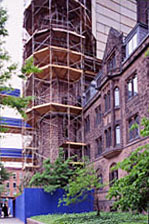If you plan to buy or renovate a building, you are probably thinking about present and future repair and maintenance issues. With an independent assessment of the building’s condition, you have:
- Less risk of hidden defects and future problems.
- A rational basis for allocating budget to repairs, if they are needed.
- Less dependence on potentially interested parties such as contractors and suppliers for advice.
And you avoid wasting time and money on issues that may not be important.
Case in Point
Address the cause, not only the symptoms.
When Yale University set out to renovate this 19th Century dormitory, the sandstone exterior walls were delaminating in patches, the cast-stone window trim was spalling, and the ornamental penthouse structure had deteriorated to the point where pieces of masonry were in danger of falling to the ground below.
 Leavitt Associates worked with architects Herbert S. Newman and Partners to identify what issues needed to be addressed and what issues could be left alone.
Leavitt Associates worked with architects Herbert S. Newman and Partners to identify what issues needed to be addressed and what issues could be left alone.
We determined that the sandstone deterioration was associated only with unheated parts of the building, that extending the building’s heating system to these areas would stop the problem from progressing further, and that insulating the exterior walls would be an unwise decision, because it would cause the deterioration to start in new areas.
These simple insights steered the University away from attempting to replace the deteriorating stone, which would have been an extremely expensive process. Leavitt Associates advised replacing the deteriorating cast stone trim, because its deterioration was caused by a chemical carbonation process that could not be stopped. We developed an effective through-wall flashing and anchorage method that ensured the new sills (made with epoxy-coated reinforcement) would not become a source of leakage in the future.

